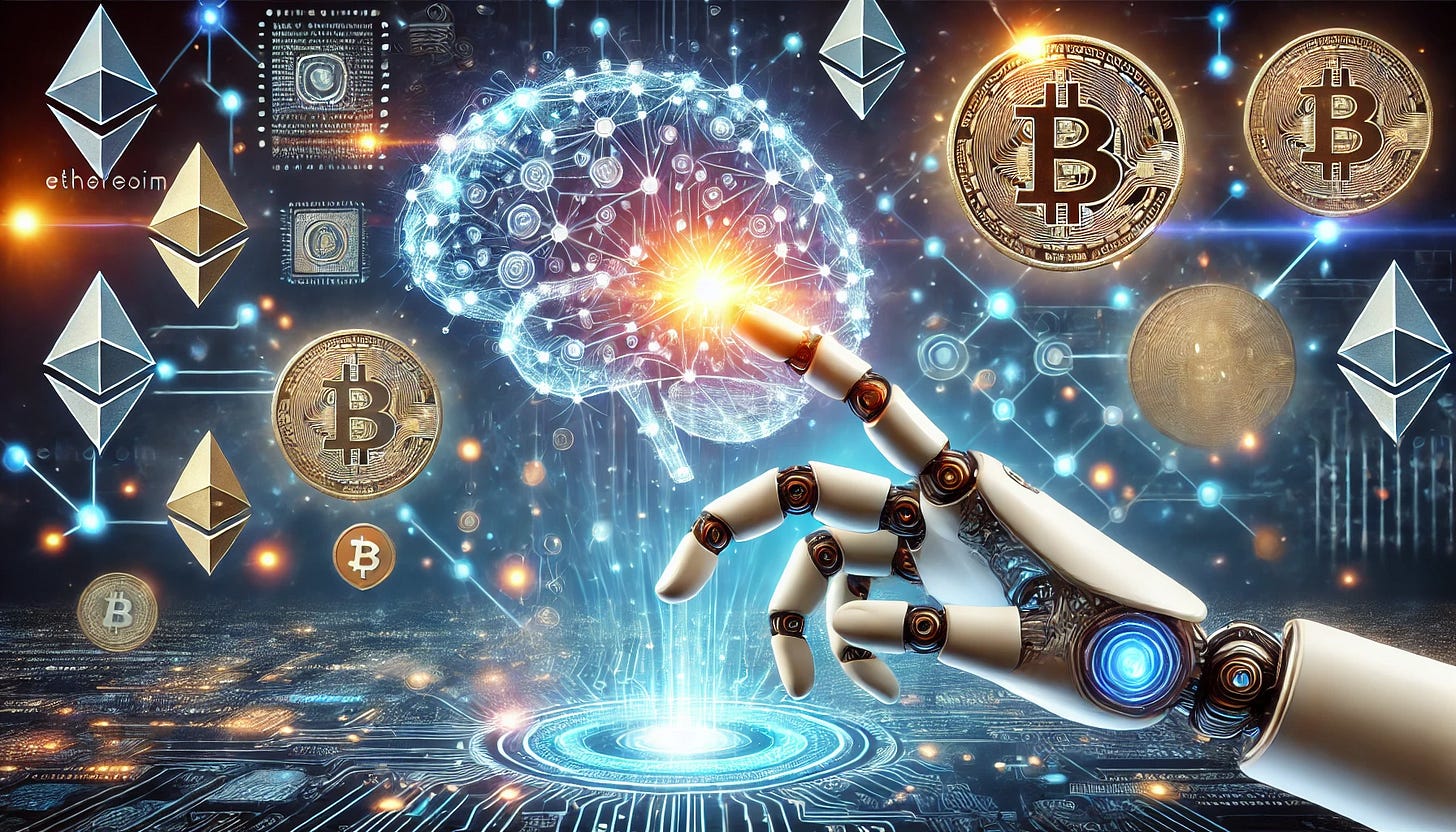The rapid evolution of both artificial intelligence (AI) and cryptocurrency is transforming our digital landscape. When these two revolutionary technologies merge, they have the potential to drive efficiency, enhance security, and democratize access to financial and data-driven services. In this blog post, we explore the possibilities that arise from their convergence, analyze key applications, and consider the challenges ahead.
1. The Synergy of AI and Crypto
At first glance, AI and crypto might seem like distinct fields—one focused on learning from data and automating decisions, the other on decentralization and secure transactions. However, their intersection creates a powerful synergy with far-reaching implications:
Enhanced Security and Trust:
Blockchain’s immutable public ledger provides a foundation for secure transactions, while AI algorithms can continuously monitor data for anomalies or potential fraud. This combination can reduce errors and prevent breaches, making digital interactions more trustworthy. For example, blockchain’s transparent record keeping coupled with AI-driven fraud detection paves the way for real-time anomaly detection in financial systems
Decentralized Intelligence:
Decentralized autonomous organizations (DAOs) and smart contracts already use blockchain to eliminate intermediaries. With AI integrated, these systems can become self-optimizing. AI can analyze vast datasets to refine contract terms or governance policies dynamically, fostering systems that adapt to changing economic and social conditions
Resource Optimization and Efficiency Gains:
AI-driven predictive analytics can help optimize blockchain operations by reducing computational waste and improving energy efficiency. In scenarios such as mining or transaction validation, machine learning can forecast network conditions and streamline processes, potentially lowering the environmental footprint of blockchain technologies.
2. Potential Applications of an AI-Crypto Convergence
a. Financial Innovation and Decentralized Finance (DeFi)
By combining AI with blockchain-based financial systems, we can expect:
Personalized Financial Services:
AI can analyze individual behavior and market trends to offer customized investment advice. This allows for personalized portfolio management and smarter automated trading—capabilities that can make financial services more accessible to the masses
Smart Contracts and Automated Governance:
Integrating AI into smart contracts can enable them to evolve over time. For instance, AI-enhanced contracts might adjust interest rates or payment terms based on real-time market data, reducing the need for human arbitration and increasing operational efficiency.
b. Enhanced Security and Fraud Prevention
Real-Time Threat Detection:
AI’s ability to process massive volumes of data in real-time can be employed to detect fraud, malicious transactions, or security vulnerabilities on a blockchain network. This not only protects users but also builds greater confidence in decentralized systems.
Data Integrity and Privacy:
When sensitive data is stored on a blockchain, AI algorithms can ensure that privacy protocols are maintained. This is particularly relevant in applications like digital identity verification and secure voting systems, where both integrity and privacy are paramount.
c. Optimization of Computational Resources
Energy Efficiency:
AI can help balance energy consumption in blockchain networks, such as those used in cryptocurrency mining or decentralized data centers. By predicting peak usage times and optimizing hardware performance, AI can contribute to lowering the overall energy footprint of these systems.
Distributed AI Platforms:
Blockchain’s decentralized nature can support a distributed marketplace for AI models. Developers could share and monetize their algorithms in a secure environment, reducing centralization in the tech industry and spurring innovation across multiple sectors.
3. Challenges and Considerations
While the potential benefits are immense, several challenges need to be addressed:
Scalability and Resource Demands:
Both AI and blockchain are resource-intensive. Merging them requires innovations to ensure that the system scales efficiently without causing bottlenecks or excessive energy use. Overcoming these limitations is essential for widespread adoption.
Regulatory and Ethical Issues:
The decentralized and borderless nature of these technologies poses unique challenges for regulation. Ensuring transparency, accountability, and privacy will require new legal frameworks and ethical guidelines. Collaboration between policymakers, technologists, and industry leaders is crucial.
Integration Complexity:
Merging AI with blockchain systems is not a trivial task. Technical hurdles—from ensuring interoperability between different systems to protecting against vulnerabilities—must be overcome through continuous research and development.
4. The Road Ahead
The convergence of AI and crypto represents a paradigm shift that could redefine technology and society. As researchers and industry experts work toward integrating these innovations, we can expect:
More Robust and Adaptive Systems:
The future may see systems that automatically adjust to market conditions, optimize energy use, and provide highly personalized services without compromising security.
Democratization of Technology:
By lowering barriers to entry, these technologies can empower small businesses, developers, and individuals, leading to a more inclusive digital economy.
A New Era of Decentralized Innovation:
The merger of AI and blockchain could catalyze the development of entirely new business models, from decentralized marketplaces for AI services to advanced governance systems that operate with minimal human intervention.
Conclusion
The fusion of AI and cryptocurrency offers a compelling vision of the future—a world where technology is not only more efficient and secure but also more democratic and accessible. As we stand on the brink of this technological revolution, the challenges are significant, but so are the opportunities. By addressing scalability, regulatory, and integration issues, the combined power of AI and blockchain could pave the way for a more robust and inclusive digital ecosystem.
The possibilities are vast, and as ongoing research and innovation continue to drive progress, we can look forward to a future where AI and crypto help build better technology that benefits everyone.
🚀 About Us
At AI Horizon , we believe that AI and technology will shape future generations. That’s why we’re dedicated to delivering cutting-edge insights and innovative tools—all completely free for our readers. Explore our AI and productivity tools at alt4.in, subscribe to our newsletters (AI Horizon and Tech Horizon) for the latest updates, support our work on Ko-fi, and join our vibrant community on Discord.Together, we’re building a smarter, more connected future. Subscribe, contribute, and join us today! 🔥
Happy exploring, and here’s to the future of AI!





